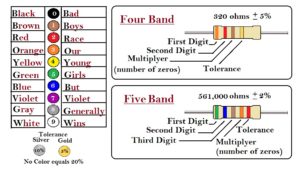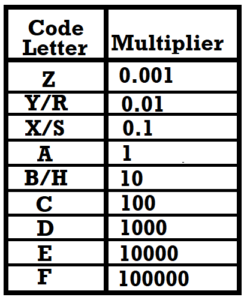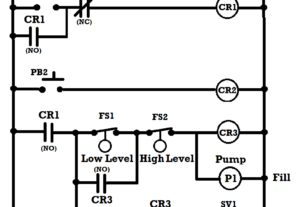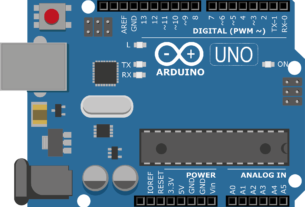Resistor values
Reading Resistor values is an important item for engineering and technology training. Price and availability go into design dissensions as well as the fabrication of prototypes. The resistor color code relatively easy to commit to memory. There are some common mnemonics for remembering the values assigned to the colors:
 The four and five banded resistors are in the majority of the through hole resistors. Just a note: A fifth or sixth band is added on MIL-SPEC resistors. The reliability band indicates how many parts per million will actually fall outside of the acceptable limits. (failure rate)
The four and five banded resistors are in the majority of the through hole resistors. Just a note: A fifth or sixth band is added on MIL-SPEC resistors. The reliability band indicates how many parts per million will actually fall outside of the acceptable limits. (failure rate)
One of the methods used to indicate the resistance value of Surface Mounted Device(SMD) resistors uses alpha-numeric codes. In this system, the first two or three digits show the numerical resistance value of the resistor and the last digit gives a multiplier. The number of the last digit indicates the number of zeros added to get the resistor value. Here are some examples of values under this system:

750 = 75Ω x 100 is 75Ω
473 = 47Ω x 103 is 27,000Ω
3992 = 399Ω x 102 is 39,900Ω
1233 = 123Ω x 103 is 123,000Ω
The letter “R” is used in place of a decimal point for resistance values lower than 10 ohms. Thus, 0R7 would be 0.7Ω and 0R05 would be 0.05Ω.
The EIA-96 marking system is used for SMD resistors with 1% tolerance. This system consists of three digits: 2 numbers to represent the resistor value and a letter to provide the multiplier. The first two numbers make up a code that equates to a resistance value with three significant digits. For example, a resistor marked 20E would be 158Ω multiplied by 10,000 = 1.58MΩ ±1% Remember that this is just an example. There are some variations.










